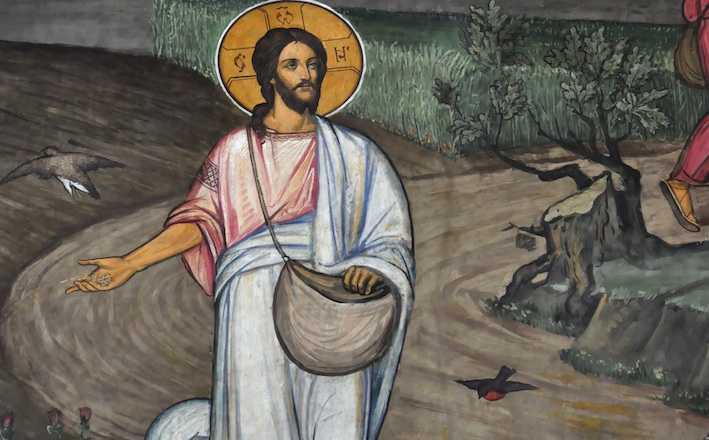Commentary on Psalm 65:[1-8] 9-13
Although the central section of this psalm is comprised of hymnic praise of God, the psalm as a whole suggests that the prayer exemplifies what Walter Brueggemann categorized as psalms of reorientation.
Psalms of reorientation are prayers uttered after the disarray and disorientation of life slips into the past. Like the ancient psalmist, we recognize and give thanks to God for the rescue for which we had longed and prayed.1 God answered the psalmist’s prayers and the psalmist is prepared to perform the vows he had vowed in his distress (verses 1-2), including, perhaps, the vow of an animal offering (compare verse 3 and Leviticus 4 and 5).
Nevertheless, for a psalm that ends with shouts and songs (verse 13), its opening reference to quiet tarrying is odd. English translations vary, but a rather literal rendition might read: “For you a still silence, [and] praise, O God in Zion; for you a payment of a vow” (author’s translation). The word translated “still silence” (dumiyyah) also appears in Psalm 62, which is a prayer of trust in God in the face of persecution. There the psalmist declares that “For God alone my soul waits in silence,” (verse 1) and with an imperative verbal form: “Only wait silently for God, O my soul” (verse 5, author’s translation).
An insight of both of these psalms is that silent, expectant waiting for God to act often is a part of our life with God. In a culture such as ours, namely one that is characterized by frantic noise and busyness and by the din of machines and the glare of large and small screens, the preacher could do worse than to prepare him- or herself to preach with some intentional still silence, listening for God.
The psalmist’s backwards glance into his past is, nevertheless, a brief one. However long his silence, after verse three the poem turns to praise that culminates with a jubilant declaration that the meadows and valleys shout and sing for joy.
The psalmist first expresses happiness that God chooses to bring people into God’s presence found specifically in the courts of God’s house, the temple (verse 4). The text makes it crystal clear that the approach to God’s presence is a function of God’s choice and of God bringing the worshiper close (“you choose,” “you bring near”).
As always this side of Eden, proximity to God is by the grace and choice of God and not our own efforts. Unfortunately, the NRSV’s indicative “We shall be satisfied with the goodness…” does not reflect that satisfaction is also hoped for and ever dependent upon God’s gracious decision. Indeed, the NRSV disguises the text’s cohortative construction of verse 4b. So with the psalmist we pray, “Let us be sated fully by the goodness of your house, your holy temple” (author’s translation).
Beginning with verse 5, the psalmist focuses his praise of God on the role of God in the creation. Water images abound since God’s salvation and deliverance include divine control of chaos, depicted by otherwise unchecked billows.
A reminder of ancient Israel’s conception of the cosmos aids the interpretation of the balance of this psalm.
Hebrews of antiquity thought the sky was a solid, translucent dome erected by God to hold out the waters of chaos (Genesis 1:6-8; Job 37:18; Psalm 148:4). The dome was held up at the extreme ends of the flat earth by mountains (Psalm 104:1-4; Job 26:10), a conceptualization that explains the present psalmist’s praise of God’s establishing the mountains (verse 6a), “girding [them] with might” (verse 6b, author’s translation).2
The dome had windows or floodgates that God opened in order to make it rain or snow (Genesis 7:11; 8:2; Psalm 78:23). The surface of the dome was populated by luminaries — the moon and stars by night, the sun by day — that moved across the face of the dome to provide the appropriate light for nighttime or daytime (Genesis 1:17-18). Psalm 65 suggests that the dome had entranceways (motsa’ey) through which entered the daytime and night (verse 8).
When, therefore, this psalmist speaks of God as “the hope of all the ends of the earth and of the farthest seas,” (verse 5b) and of God’s having established the mountains (verse 6), he has in view divine mastery and management of the world. That authority is characterized by God’s control of chaotic waters (see Genesis 1; Psalms 89:10; 93:3-4; 104:5-9; Job 38:11). Whether roaring seas or tumultuous peoples, none are a match for God’s power (verse 7).
More than control the chaos, however, God subordinates chaos water and employs it for God’s own good intentions. God converts the waters of chaos to an instrument of shalom, producing grain to feed God’s people (verses 8, 13). Freshly plowed soil, with its sharply furrowed edges, are softened by gentle rain and readied for growth (verse 10).
It is unclear if the wagon tracks of verse 11 refer to the earth’s furrows in verse 10 or to an image of God’s chariot cutting through the clouds (see Psalms 18:10-12; 68:4; 104:3), releasing rich, fructifying rain. In any case, the image means to convey luxuriant abundance. The wagon tracks overflow with “richness,” (dsn). The word means fatness or fat ashes, but more broadly it signals rich satisfaction and fullness that comes with the presence of God (see Psalms 63:6; 36:9).
The psalm concludes with a summons that the meadows and valleys, covered with abundance in the form of flocks and grain, might shout and sing for joy. As shouting and singing were characteristic of ancient Israel’s worship,3 the image intends to help us understand that the very creation worships God.
Several themes emerge as possible directions for preaching. The motion of the psalm from quiet, expectant waiting to a summons for the creation itself to join the choir of praise suggests that the journey from expectation to exaltation is just that — a journey. Many of us, perhaps most of us, find ourselves somewhere in the middle of the journey. We recognize that God in Christ has answered our prayers.
In our baptisms we have been claimed by God and brought into the richness of God’s presence. Indeed, we have been incorporated into the body of Christ. And yet, for many of us, perhaps most of us, chaotic powers still affect us. Whether the chaos is a still unstable economy, a newly unstable marriage, grief, illness, loneliness, or a sense that our lives are adrift in a formless chaotic sea, our God remains master of the tumult.
Or, better, we can confidently claim that this God has joined us in our tumult. If we find ourselves awash, we know that God in Christ has likewise suffered as we do. Christ experienced loss and being lost to the depth that we have and more, and yet he comes to us with the firm intention to stay with us until we arrive at that valley where even we, the flock of his pasture, will to shout and sing with joy.
Notes:
1 On psalms of reorientations, see Walter Brueggemann, The Message of the Psalms (Minneapolis: Augsburg, 1984), 123-167. Brueggemann regards Psalm 65 as a thanksgiving song of the community, albeit he notes that “there is something of a mismatch between the subject of verses 1-5a and the doxology that follows” (136).
2 Reading this unique niphal masculine singular participle with an active voice rather than the usual passive or reflexive. The niphal does allow an active sense for some verbs (e.g,, nchm, “repent”). Moreover, the verb ‘zr does appear as a reflexive (hithpael) in Psalm 93:1 and Isaiah 8:9 and 9:8. Thus, participles of both stitches refer to God’s action upon the mountains:
mkyn hrym bkchw
n’ar [hrym] bgbwrh
3 See Psalms 71:23; 81:1; Isa 12:6; 24:14; 42:11; 44:23; 54:1; Zephaniah 3:14.


July 13, 2014